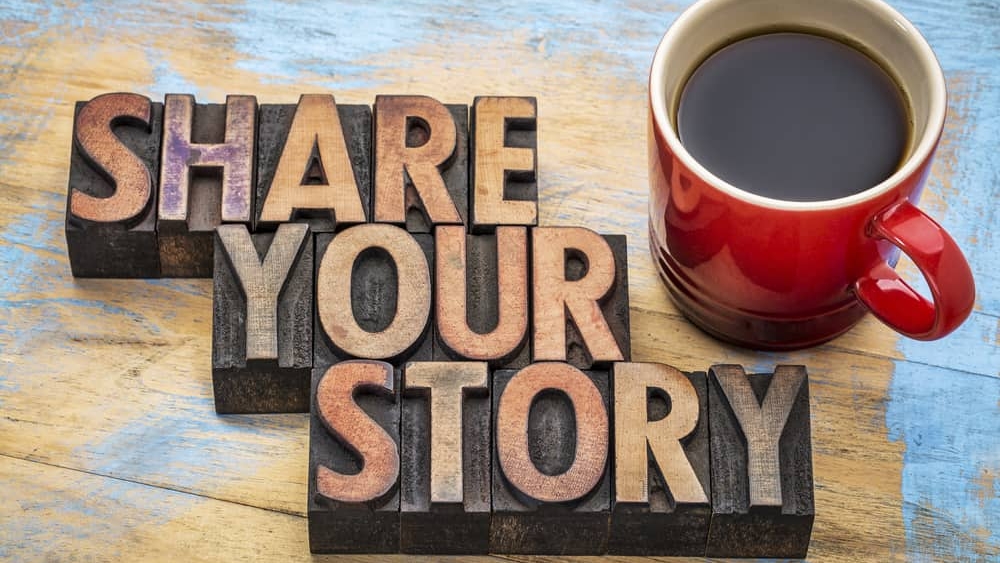Overview
You’ve probably heard the term Expert Positioning Story in business before. It’s become one of those things-you-know-you-should-have but truth be told, most business owners don’t know how to pinpoint their story let alone how to write it and share it with others. The term Expert Positioning Story itself feels so definitive. You’re a lifetime in the making, so what do people mean when they say, “your story”? Like, once you’ve told it, is it set in stone, always defining you, never to be changed? And even if you do know exactly what led you to the point you are now at, writing it down, particularly with the intention of publishing which has a degree of permanency, raises questions such as, How much is too much? Is that relevant to business? Does anyone really want to hear this?
The answer, in a nutshell, is yes – they not only want to hear it, they expect it. However, there are some caveats. The good news is these are easily explained, as are the principles you can follow to create a compelling Expert Positioning Story that positions you as the expert in your field, rather than a life story that bores people half to death or makes you sound like a cynical weirdo.
This article, therefore, attempts to simplify the telling of your Expert Positioning Story in your business content by answering the following three questions:
- What is an Expert Positioning Story?
- How do you tell your own Expert Positioning Story?
- How do you share it and who with?
I not only share with you the ‘what’ and the ‘why’ behind the answers to each question, but also the ‘how’, with visual examples, so you can apply these principles immediately to your own content, whether it’s for your website, business book, presentation or bio. When followed, the steps shared in this article will take you from staring at a blank page to being the author of an engaging, compelling and authentic expert positioning story that you feel comfortable and confident sharing with your professional connections.
What Is An Expert Positioning Story & Why Have One?
One of my jobs as a Publishing Consultant — that is, I write people’s non-fiction books for them using their own content to create a book to serve their audience while meeting their own commercial goals — is to help people identify and then tell their Expert Positioning Story (EPS). This is an important component of any business book because it is how the reader, otherwise known as the author’s ideal client, relates to them and buys into them as the voice of authority on that topic. A weak EPS will lose readers.
The reason I say I help authors ‘identify’ their story as a first step (don’t they know it already?!) is that a lot of people, business owners in particular, despite setting up their business as a result of realising or at least pursuing their ‘why’, still don’t often know how to talk about it. Many struggle to say what it is. And when I take them through the exercise that pins it down and they inevitably have to share it with someone (i.e. me), they can even feel a little emotional as they release the narrative they’ve been holding onto and again as they realise they have never once shared that story before. Even if they have, they may not have shared it in a structured, professional context.
How about you? Have you ever said out loud before the story of the life event or series of events that is so fundamental to your very being? Have you ever shared it with your spouse, children, friends or clients; the people who need to connect with you the most? If the answer is no, then isn’t it crazy to think that the people who count on you more than anyone else in the world don’t know that part of you. Yet that same story has become a part of how you motivate yourself. It may even be what gets you out of bed in the morning to do what you do. It’s the origin and subsequent implementation of your ‘why’.
In my experience working with hundreds of entrepreneurs, successful in business by most if not all objective standards, the events behind their ‘why’ can be linked to a time of hardship of some description, be it pain, loss, heartbreak, fear…something they wanted to move away from and create a better life as a result of, and it becomes engrained in their sense of purpose. They are so motivated by those events and the ideal future they’ve imagined in contrast, that they work incredibly hard doing the things that 99% of others are not prepared to do, to get to where they want to be.
If you think back to a time in your life when you experienced something negative, you may realise that you flipped into survival mode living with a day to day focus rather than a bigger picture perspective. You have to become more resourceful during those times. Whether it’s physically, financially, emotionally, spiritually, you have to ‘dig deep’ and so it’s in those times of stress and doubt that we often discover our greatest natural gifts. We have to dig deep down within our souls to find the innate strength and sheer faith that will see us through. We connect most deeply with our beliefs and values in times of need, because those times force us to question ourselves and the world we inhabit.
And as we improve our life, we grow and start to see progress. We learn to balance periods of stability with periods of risk and chaos, accepting them all as part of the journey and eventually embracing inevitable (temporary) failure as the best teacher. We gradually move away from the original position of need, towards a position of want. And life is much better. You enjoy yourself more and more often. Your comfort zone has expanded so you feel fewer fears than before and that leads to a type of confidence. The further away from your starting point you get, the more you feel a sense of clarity – the benefit of hindsight. That starting point no longer defines you. You have a new start point and a bigger end goal. You look forward.
And so the origin of your EPS can easily, naturally, become viewed as irrelevant and consequently forgotten. This is especially true if the individual fails to make gratitude and creative happiness daily practices, or fails to manage their ambition. Entrepreneurs can become so focused on the future and the pursuit of their goals, they can become easily disenchanted with their current reality and forget where they’ve come from when they start measuring forwards rather than backwards.
Until someone, like me, comes along and asks, “Why do you do what you do?”. And you say the thing you usually say; “I’ve always wanted to make a difference”, or, “I want to help people; that’s what drives me.” “I’m here to make a lasting change”. And I ask annoying questions like, “Ok, why is that so important to you?”, or, “Tell me the earliest memory you have of caring about this”, or, “Write down the most important events in your life and business to date” and so on. And I dig and dig and dig until I can pinpoint the moment in time their ‘why’ began.
And then I do the same with everything related that’s happened since until I have a consistent narrative that can be viewed as a trajectory of that person’s progress throughout their life. Once you have that trajectory for someone, you can pinpoint critical junctures along the way – highs lows, triumphs, failures, wins and losses, and piece them together to form that person’s EPS.
It’s not easy for someone to do for themselves because you lack objectivity on your own decision-making and you may be unaware that certain events are of significance. If you don’t have your EPS yet and you are in business, now that you have an understanding of what an Expert Positioning Story actually is, you are ready for the process that will help you do yours.
The Anatomy Of The Best Expert Positioning Stories
Your EPS visualised resembles a bell-curve which can be split in two to reveal:
- Your start point (A)
- Your Origin Story
- Your Trigger Story
- Where you are now (B)
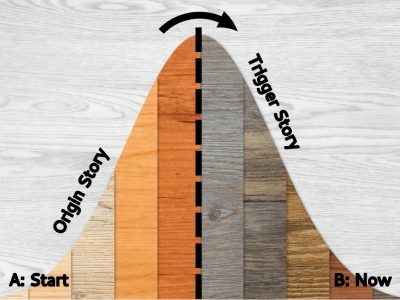
Origin Story
Your Origin Story is exactly that moment(s) in time that explains where your passion and purpose come from. It’s not always easy to identify this straight away, so unless you’re working with a professional you might find this is a process of exploration of your past. As much as you might just want to get on with it and write your story so you can finish your book/site/presentation, it can take a little time. If you feel that’s the case for you, try to give it the time it needs. Even with someone doing this with you, the questions they ask will prompt thoughts, memories and feelings that you need to ‘sit with’ and let go down. You might have to go back over events you previously put effort into forgetting. Perhaps you’ll revisit things you thought you’d moved on from, only to discover that you haven’t quite as much as you thought.
Your Origin Story might not be sad at all. It could just as easily be a happy set of circumstances that led you to develop your passion for your craft. Whether your Origin Story has a positive or negative source may depend upon how you’re motivated. For example, someone who motivates themselves by moving away from something may have prior negative experience as their driver. Someone who motivates themselves by moving towards a positive experience is more likely to find their Origin Story within a ‘warm’ memory.
My Origin Story was hard to get to because it involves loss. Ultimately though, facing my grief led me down some wonderful memory lanes which helped me to realise that loss and who I am are all a part of the same process. I thought of my earliest influences in an effort to pinpoint exactly where my love of language and books comes from. My Grandmother – Granny – played such a big part in my upbringing and learning around my passion that I started there and worked forward in chronological order, thinking of all the events I could remember which involved my grandmother and books and me. I was then able to select a small handful of stories within those events that best describes her influence on me, and write them up descriptively:
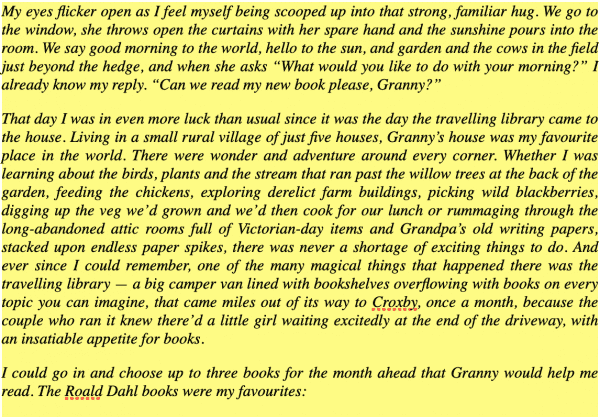
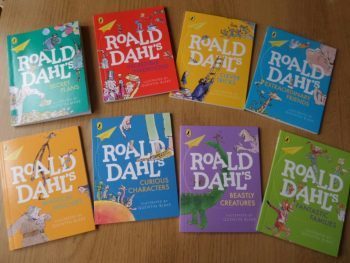
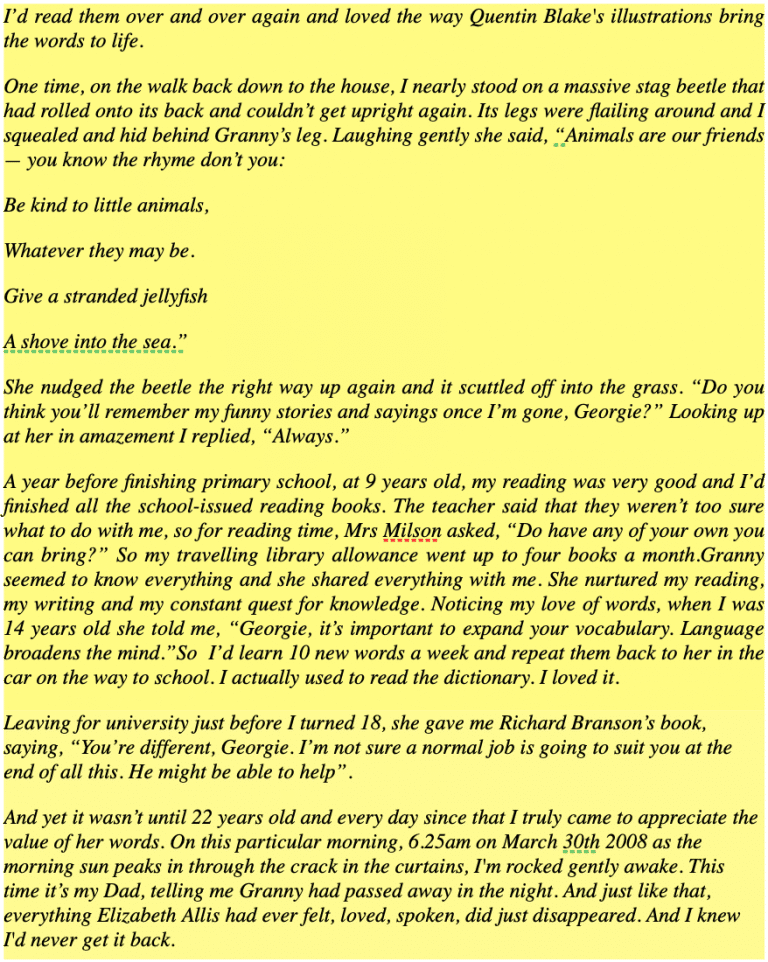
I realised my Origin Story as soon as I started reminiscing with the intention of discovering where my passion for my field. I’ve used The Immersive Method – one of the five main storytelling techniques I use in content writing for business – to write it out since I tell this story during presentations. Audibly, it’s better for the audience. If I were to include my story in my book, I’d write it out more like the example below which is better for the book format.
I wrote my Origin Story out in rough notes over the course of eight weeks, rather than forcing myself to write it all in one go which would have been too intense. It was a genuine exercise of reminiscence before it became a more technical exercise in content creation.
This very different example comes from the book, ‘Evolve To Succeed’ by Warren Munson:
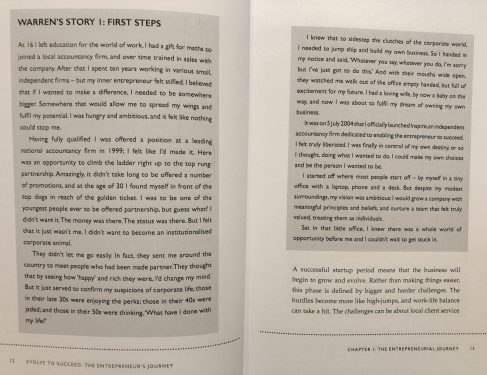
Warren winds and weaves his story into the main body of his book in segments throughout, which allows him to lighten the load on the reader while giving them plenty of insight into his ‘why’, his values, where he’s come from and where he wants to go next. This gives him credibility not simply because he states he’s an expert in scaling small businesses, which is the topic of the book, but because sharing so much about his own journey makes him authentic and relatable to the reader.
They go on that journey with him throughout the book while he helps them with theirs, and at the end, he also tells them where he is now so they can see him as a role model; someone who’s walked in their shoes already and can, therefore, guide them. The reader also feels a shared experience.
Telling your Origin Story allows you and your reader or audience to form an empathetic connection. This is important for any ongoing business relationship, and imparting information through storytelling also makes it easier for the human brain to retain that information (versus when we receive simply factual information, which doesn’t stimulate the brain as much making it harder to recall later).
Trigger Story
Your Trigger Story is the moment you realise you must take action on your sense of purpose and decide to start your business OR take your existing business in a new and exciting direction with fresh conviction. This might come much later than your Origin Story, or it might be the result of your Origin Story. Your Trigger Story is usually far easier to identify than your Origin Story because it’s typically a conscious choice versus an occurrence outside of your control.
For example, if your Origin Story, like mine, is something that happened when you were younger you would have been, at the time, less able to comprehend it with the same level of self-awareness, emotional intelligence and critical evaluation you would as an adult. You’d be more likely to take it in subconsciously and be shaped by it without even realising in that case. Your Trigger Story, on the other hand, is based on a decision you make in response to an event that reminds you of your Origin Story.
It describes how you’ve overcome that challenge or solved the problem. In my case, an unexpected event six years after losing my Grandmother made me question my career and go on to establish my business. While I didn’t realise the connection between the two situations at that time, I came to later:
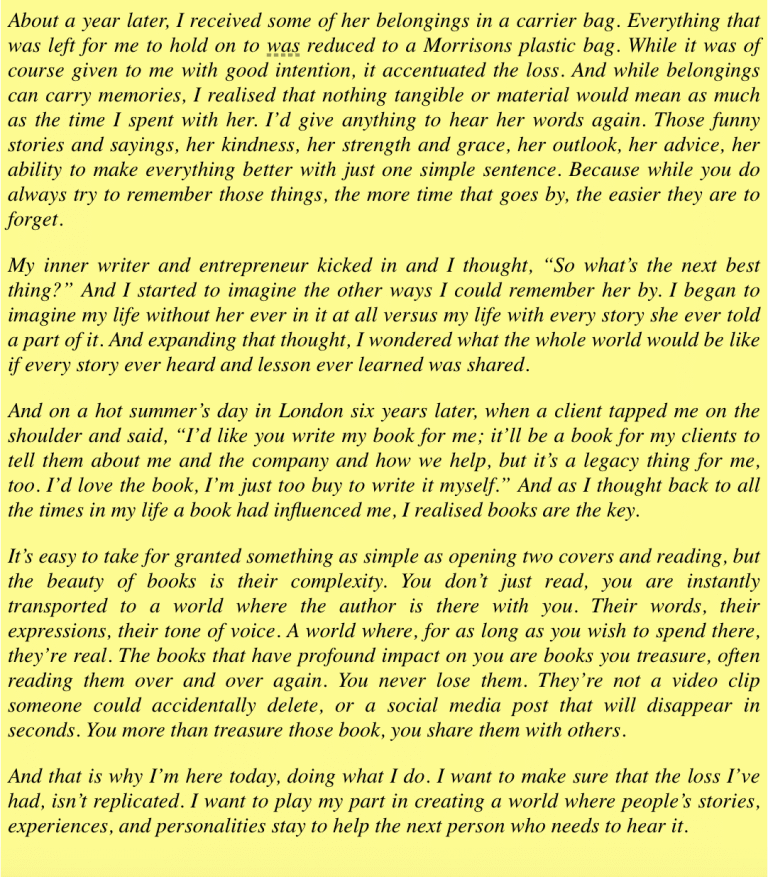
So while I always had a passion for books and writing, I’d also been told that it couldn’t be a ‘proper career’, not a ‘real job’ etc so I focussed on another area of interest – business – professionally, while keeping my writing as a hobby. And it wasn’t until someone actually asked for my help that I realised its place in my professional life and I finally recognised it as something I could and should be doing for people every day.
In telling your Trigger Story, therefore, you’re describing the time you apply yourself to what you’re doing now. It’s when paths converge, a moment of clarity, a change in direction for the better. Your adversary doesn’t have to be hugely negative or cover a big theme. It could be that you had an amazing experience and you realised, as a result, a new way to help others. However, in order for people to see you as an expert in your space, you will need to demonstrate a personal connection to what you’re doing and that usually involves at least one but likely several challenges.
No deep understanding of anything comes easily. And only when you’re passionate about something are you prepared to put the time and energy into developing a business out of it. I’m sure we’ve all seen ‘experts’ online or at events who do not demonstrate one iota of passion or connection to their craft. They only ever talk – often, maniacally – about making money using their product/service and it sounds phoney. Because it is. Chances are they made their money doing something other than what they’re selling. Their tactic is to pump buyers up and make quick sales.
Taking the time to demonstrate who you are and why you do what you will set you apart from those others and likewise enable like-minded clients to find you. Your EPS is an essential means for sharing your values and forming genuine connections as a result.
Creating your Expert Positioning Story
With this in mind, how can you go about creating your own EPS? Remember the component parts and complete your content using the guide below:
- Your start point (A)
- Your Origin Story
- Your Trigger Story
- Where you are now (B)
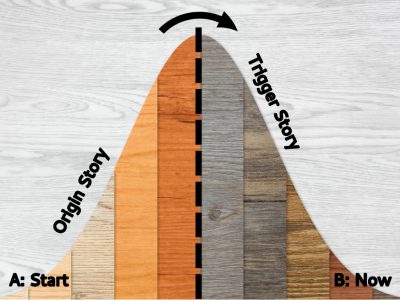
1) Your start point (A)
Write down where you were at in terms of your mindset, your career and your personal life when you started out on your current journey. This should match or empathetically link to where your ideal client is now.
2) Your Origin Story
Write down the answers to the following questions:
- Why do you do what you do?
- Why is that so important to you?
- What is the earliest memory you have of caring about this?
- Write down the most important events in your life and business to date
- Shortlist the top 3 and look for the overlap/themes.
Now, share what you’ve written with someone close to you. Encourage them to ask questions and ask them what they think or what they might have done in your shoes at those times. Keep writing down all the memories and questions this process raises because that will help you to keep on making connections between things.
You are aiming to form a succinct and consistent narrative. It’s easiest to think chronologically, and then you can start to see through mapping out your memories in this way exactly what the crucial turning points in your life are that are relevant to getting to where you are today. You will know when you’ve got to the events that form your Origin Story. It will make sense to you. The write up of your origin story should be descriptive without being too long- aim to get in on less than two sides of A4.
3) Your Trigger Story
Write down the answers to the following questions:
- At what point in your life did you decide to set up your business?
- Why was it important to you at that time?
- How did your earlier experiences shape your perspective and lead you to your field?
- What challenges did you face and subsequently overcome once you started, and how?
Once you’ve brainstormed, you can start to write these events up in prose, keeping it to less than a side of A4.
4) Where you are now (B)
To complete your EPS, link the events you’ve told to what you do now (versus the why, which is what you’ve just covered):
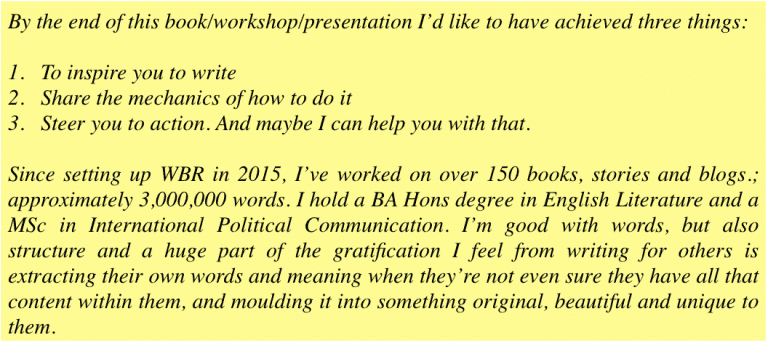
How Do You Share It & Who With?
You will want to edit your story depending upon how you’re sharing it, but your EPS can be told throughout your marketing in all formats. As a rule of thumb:
For your book…
It’s essential to include your EPS early on in the book. Be mindful not to saturate the first few pages with it, however. Research from publishing houses in the US indicates that the number of readers who read to the end of your book drop off to a third or less when your book is over 150 pages long. That puts pressure on the first few pages to genuinely connect with and engage your reader. Make the focus all about them, bringing yourself into it to help them understand why they should listen to you and read on. You can always unpack the details of your story later on in the book.
For your presentation or workshop…
You only have around 90 minutes to impress and engage your audience. To make them count, you may only wish to spend 15 minutes or less talking about yourself. You do want to show your audience that you are a reliable and trustworthy source of this information. Try telling your EPS upfront, then provide short and sharp examples of your other relevant experiences as you go through your presentation, using them only to highlight the important points. You should also include an abridged version of your EPS in your speaker bio.
For your website and social…
Include an Our Story section on your website and don’t be afraid to share how you got into your line of work, what it means to you and what your goals are. This can go in your social media bios, too. Think of it as a modern-day approach to your Mission Statement. Nobody cares for those generic blanket statements anymore, but they do care about how much you care. Telling your EPS allows you to add personality to your brand and give your company a story, too. People want to connect with people, not logos or cheesy headlines.
Who do I share my EPS with?
As for who with, the power of a well-written EPS is that it’ll weed out people who are not the right fit for you to be working with. It is a values-based, empathetic approach to sales and marketing that genuinely serves your prospective clients because they can see ahead of engaging with your company what you stand for and aim for. You can’t please everyone – those who are successful in business, who are prolific, are not afraid to share who they are and where they’ve come from. They don’t worry about impressing people in that way. They would rather work with people who genuinely ‘get them’ and align with their beliefs. So share it with everyone, share it freely. Just make you have a clear understanding of who your ideal client is so that you know when they enquire!
The goal of having an Expert Positioning Story is to work with people who understand and respect your unique skill set so that you’re providing a service that really means something to them, versus a commodity. It is part of becoming more niche and targeted in your approach and becoming more valuable as a result. While you may be able to help different groups, it pays to have a clearly defined customer avatar.
Next Steps
Have you written your Expert Positioning Story yet? If so, what difference has it made? We’d love to hear from you.
For more information on the writing support available to you, visit www.writebusinessresults.com or email / phone us on info@writebusinessresults.com / 020 3752 7057.
